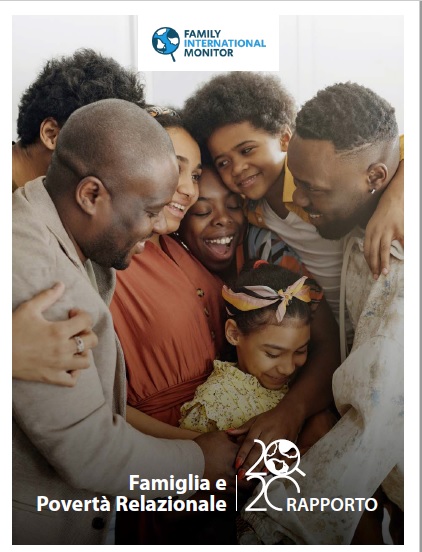The Family Is a Bulwark Against Poverty
Previews of the First Report Made by the Family International Monitor

Family and Poverty was the focus of the attention of the Family International Monitor, which is made up of the International Center of Studies on the Family (ICSF), the John Paul II Pontifical Theological Institute, and the Catholic University of Saint Anthony of Murcia (CUAM), in its first three years of activity, pursuing its research along two lines, and reflecting first on relational poverty and then on economic-structural poverty. The Report will be present in the coming weeks. In the meantime, a synthesis of it has been made which shows very interesting data.
Global Priority
Francesco Belletti, Scientific Director of the Family Monitor explained how the intertwining between relational poverty and economic poverty is “a priority at the global level, as seen also by analyzing the 17 Objectives of Sustainable Development — the United Nations’ 2030 Agenda. The work of the Family International Monitor intends to highlight the role that family relations play in describing people’s condition of poverty and in promoting their resilience in difficult conditions, paying particular attention to systems of relations extended around families, as well as to more macro-social dynamics such as social bonds of community or neighborhood, social cohesion, and solidarity of short relationships,” continued Belleti.
Inequalities in Growth
It is a precious analysis in this time of pandemic that, undoubtedly, has extended the problems both at the relational as well as the economic level. It is a photograph that could reveal a useful instrument to set up policies able to support the family network, which yet again has been revealed as the most precious in addressing the umpteenth crises of the last decades. Emerging clearly from the Report is the necessity to compare the very great conditions of socio-economic inequality, which have grown over the last 20 years, in practically all the analyzed national contexts.
The Twelve Countries Examined
The data collected examines some particularly significant countries, by geographic area, in four Continents: Benin, South Africa and Kenya for Africa; Brazil, Chile, Haiti and Mexico for the Americas; India, Lebanon, and Qatar for Asia; Italy and Spain for Europe.
The research used 90 grouped indicators in eight different thematic areas that could furnish homogenously a general statistical reference for every country, using as priority sources the World Bank and the United Nations. Singled out in each country, moreover, was a Research Center, which elaborated a Country Report on the basis of a questionnaire, keeping present four aspects in particular: the family as economic actor, as educational subject, as subject of care and reciprocity, and as subject of active citizenship.
The Difficulties of Reconciling Family and Work
From the research, some common problems emerge worldwide, such as the difficult family-work reconciliation (not only for women), or the impact of communication technologies on family relations, and the growing internal socio-economic inequality in individual countries, perhaps graver than the inequality between diverse countries.
Family Relations Are Decisive against Poverty
In this context, family relations make the difference. Revealed in particular with great clarity for families that are particularly vulnerable from the socio-economic point of view, is that the strength of family relations is a decisive factor to impede falling under the threshold of poverty. In turn, it is equally clear that the strength of family relations shows a significant correlation between the institutional dimension of marriage and the family, that is, families with higher levels of legal recognition show greater indicators of holding together, of family quality, and of wellbeing. Hence, the couple is the primary resource of the family’s quality, especially in conditions of grave socio-economic vulnerability.
Also emerging from the Report is the great importance of wider relational networks, both inter-generational and non-parental as neighborhood, friendship, and associationism.
Relational Fragility
On the contrary, internal dynamics of intense inequality between the stronger members to the damage of the weaker (in general adult males at the expense of women, minors, and the elderly), appear correlated to lower cultural levels and social marginalization. Moreover, some family forms are structurally more fragile than others: one-parent families, with one or two adolescent parents, and numerous families. In some cases, these vulnerabilities can be supported better by welfare interventions.
Three Risk Areas
In regard to individual internal fragilities, three specific areas of attention emerged with particular evidence: the birth event, still charged with risks of life (for mothers and new-borns) in many countries, often exposed to the child’s abandonment and who is scarcely protected; young people’s condition, heavily penalized in almost all the countries considered, and violence in the family, concealed but widespread phenomenon, noted in all territorial contexts and not only in the socially poorest classes.
Specific Data
In regard to some specific data, on one hand, the size of families is an objective relational resource but also a powerful factor of vulnerability. The reduced dimensions of families in Italy and Spain, emblems of aging, and the fall of the birth rate in Western Europe confirm a negative demographic trend.
Fertility Rate and Young People
In Africa, the average number of the family’s components goes from 5.2 in Benin to 3.4 in South Africa, a population under 15 years that goes from 42.4% to 28.1% and a fertility rate between 4.9% and 2.4%. In America, with the exception of Haiti (4.3 average components per family), it oscillates between 3.3 in Brazil (where the population under 15 years reaches 47.2% to 3.7 in Mexico. The percentage of young people is lower in Chile (20.4%) whereas the fertility rate ranges from 1.6 for Chile to 2.2 in Mexico and 3 in Haiti.
The most numerous families in Asia are in India (4.8 components and a 2.2 fertility rate, children constitute 27%), the least in Lebanon (3.8 components with a youth population of 26.1% and a 2.1 f fertility rate), whereas registered in Qatar are 4.7 components per family, but only 13.5% constitute the young population and hardly 1.9 of fertility, compared to the highest per capita income in the countries taken into consideration, with US$124,410 (at the tail end Haiti with US$1,880 per capita, followed by Benin with US$2,410.
Ageing Europe
In Europe, instead, there are no essential differences between Italy and Spain, with, respectively, 2.3 and 2.5 components per family, of which only 13-14% of the population is under 15 years of age and the fertility rate is 1.3, very far from the threshold that guarantees generational replacement (conventionally fixed at 2). It is a demographic winter against which it is ever more urgent to find effective remedies, supporting the family also on the economic plane.
Adolescent Mothers
Finally, in regard to vulnerability, the data confirms that the single-parent household is now a consolidated not marginal phenomenon (around 10% of the total of family nuclei except for India) and that it is primarily linked to single mothers. The presence of adolescents’ maternity is a much more effective indicator of vulnerability; it varies from 5.2cases of pregnancy out of one thousand adolescent girls in Italy to 78 in Benin and 75 in Kenya. These cases are marked by a double vulnerability that affects the subjects both as minors and as women.
Related

Saying Goodbye to Francis
Exaudi Staff
26 April, 2025
2 min

The Family: A School of Love, Forgiveness, and Hope
Laetare
25 April, 2025
3 min

Pope Francis: Leadership That Transforms Through Service
Javier Ferrer García
25 April, 2025
4 min

The heart of the Church beats between mourning and hope
Exaudi Staff
24 April, 2025
2 min
 (EN)
(EN)
 (ES)
(ES)
 (IT)
(IT)

